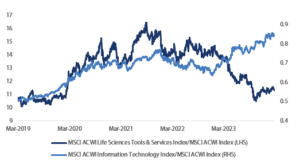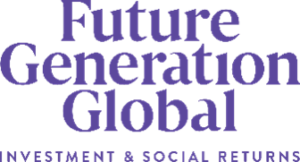Middle-aged Scottish men (of which there are a few in our office) tend to become subjects of good-natured ribbing. Some of it, admittedly, is deserved. One of the shortcomings often noted is their reluctance to seek medical help in the face of mounting evidence that it is the right thing to do. Unfortunately, this “head in the sand” tendency often produces bad outcomes that could otherwise have been avoided.
Ignoring the healthcare sector has been easy to do over the last couple of years —even though, in our view, the case for owning it has never been stronger.
Part of the reason the healthcare sector has been overlooked is due to the financial volatility caused by the COVID-19 pandemic. Some companies benefited from increased demand for their products and services during the dark days of 2020–21 and then lost out as (thankfully) the pandemic subsided. Others lost out and then benefitted, as patients returned to their doctors for more routine healthcare needs. Over the last couple of years, many healthcare companies have been labelled as “too difficult” due to the challenges of determining their financial standing. This includes assessing whether they were on the positive or negative side of the ledger, and predicting when “normal” demand might re-emerge.
Time and patience have been necessary to reveal the answers. As we move further into 2024, the fog of uncertainty is starting to lift, providing a clearer perspective. It is now widely accepted that a fair picture of COVID-adjusted trend growth can be obtained by combining two years of pre-pandemic growth rates, two years during the pandemic, and two years post-pandemic. Even if the healthcare sector has endured a difficult 2022–23, we will not be afraid to add to our positions in areas where we believe that the trend growth looks strong and sustainable, and the valuation attractive.
Our holdings in the life science tools subsector, such as Danaher and Bio-Techne, are good examples. Due to unprecedented post-pandemic destocking, a Chinese regulatory clamp down and a necessary return to more focused investments by the biotech industry, 2022 and 2023 have been difficult years. However, we believe that we are only in the very early stages of a new wave in scientific/medical advances—one in which a greater understanding of the human genome allows us to target new areas for medicines with artificial intelligence (AI) expediting the identification of treatments that are most likely to work. Consequently, the order books at both companies could start to fill up quickly as we move into the second half of 2024.
A return to growth should allow the life sciences and tools subsector to recouple with (or even outperform) other growth sectors such as IT that consistently deliver high cash returns on investment. The IT sector quickly addressed its post-COVID demand growth blip through very assertive cost-cutting and the rise of AI.
Chart 1: Life sciences and tools vs. IT
Source: Bloomberg as at 21 March 2024.
Why take an umbrella when it is sunny outside?
It is also fair to note that economic conditions have remained better than many observers expected. In particular, labour markets have been tight, allowing positive real wages in many sectors and supporting consumer confidence. Why increase your exposure to a relatively defensive sector like healthcare when the economy is purring, the Fed is about to cut rates and we could enjoy the softest of soft landings?
We are far from economic doom-mongers. We do not subscribe to any extreme economic viewpoints. We would always prefer our stock selection to speak for itself, rather than require a bit of amplification from macroeconomic conditions.
Given the optimism observable at present, in terms of stock market levels and financial conditions, we do think that a bit of insurance makes sense—just in case interest rates do not come down as quickly as expected or if emerging pockets of economic softness grow in size.
It helps also that our most defensive holdings within healthcare all have stock-specific attractions that matter more to us than their average beta of 0.7.
Cencora, Elevance and Encompass Health are all expected to benefit from sustained, demographics-led demand growth; they also offer services that will be indispensable in lowering the cost of healthcare delivery. Cencora stands to benefit from improved distribution dynamics as US$200 billion worth of US prescription drugs lose patent protection over the coming five years, a change that will also benefit patients. Elevance has embraced value-based care, tying the payments they receive as healthcare insurers to the health benefits patients receive (and replacing the old, less efficient fee-for-service model).
Meanwhile, Encompass Health’s inpatient rehabilitation facilities are increasingly recognised as providers of the best quality post-acute care for patients. Often, they offer a more cost-effective solution compared to alternatives such as nursing homes or general hospitals.
You don’t want all your eggs in one (AI) basket
By staying invested in healthcare, it is not just the possibility of an economic downturn that we are protecting our clients’ capital against. The sector also offers welcome diversification from some of today’s most exciting parts of the market. To borrow a seasonal metaphor, we do not want all our (Easter) eggs in one (thematic) basket.
We are firm believers that the infrastructure for generative AI will be developed, even as we wait for the emergence of pivotal applications. We do not have to wait, however, for healthcare’s socio-economic necessity to be established. We have long remained convinced that companies whose technology allows us to maximise our economically active years and minimise the cost of delivering these will enjoy the sustained, profitable growth that is the hallmark of Future Quality.
There is gold in them there pills…
Admittedly, when gold assayer Matthew Fleming Stephenson made his famous remark in 1849, he was referring to hills, not pills. Indirectly quoted in Mark Twain’s novel The American Claimant, Stephenson declared, “There’s gold in them thar hills” in an attempt to slow the emigration of gold prospectors from his native Georgia to California. Indianapolis and Denmark are not known for their hills, but the only gold that investors have uncovered in healthcare in the last couple of years has been found there (in the form of Eli Lilly and Novo Nordisk). Their reformulation of well-established diabetes agents into effective treatments for weight loss, and clever marketing, has created huge excitement.
A relatively little-known fact is that Scotland has had an important role to play in the creation of this craze. The music for the “Oh Oh Ozempic” commercial which has become synonymous with these drugs in the US (Ozempic having the same active ingredient as weight loss product Wegovy) is from the 1970s hit “Magic” by Edinburgh pop rock band Pilot. The share price impact of these drugs has certainly been worthy of another Edinburgh-based creation, Harry Potter.
The parabolic increase in share prices for these two companies has seen them almost keep pace with the champions of generative AI. Similarly to AI, the science behind these new drugs is not as new as the stock market’s reaction would have you believe. While it may not date back as far as the formative research on AI in the 1950s, GLP-1 was discovered in 1986 and it has taken almost 40 years of scientific research to get to the current level of understanding.
It will take longer still to resolve several questions that remain outstanding regarding these drugs. How long will patients need to take them? Will weight be regained if they stop? How safe it is to lose up to 25% of your weight in one year? How much will they cost, in the long term? And can the supply of the drugs keep up with demand?
One of the most important questions in the long term, however, is: can the US healthcare system afford to pay for these drugs? Or, put another way, can it afford not to, given the high cost of treating many of these patients already being borne by the system?
We are continuing to carefully research in this area, and that research extends beyond Eli Lilly and Novo Nordisk. It appears to us that the most lucrative place to be in the long run could be among the providers of the “picks and shovels” necessary for this seam to be successfully exploited. These picks and shovels span everything from active pharmaceutical manufacturing and distribution to the glass vials and injectors used in sterile fill and finish.
Conclusion
We remain very strong supporters of the healthcare sector. In addition to the well-known demographic drivers (ageing societies, rising prevalence of chronic illness etc), innovation is enabling structural changes in healthcare delivery and in our view these changes will confer years of strong organic growth opportunities if we choose the right companies.
Mark Zuckerberg famously encouraged his employees to “move fast and break things”. However, breaking things can lead to severe consequences in a clinical setting; furthermore, it is not in keeping with one of the core principles of the Hippocratic oath: “First do no harm”. As a result, change happens more slowly in healthcare than in other sectors. The changes underway at present, however, are profound, and we believe it will play out longer than in other areas.
When you need medical attention, waiting seldom makes things better. It normally just means that a more assertive intervention is needed when the time comes. Similarly, waiting to invest in the secular growth on offer in the healthcare sector, whilst putting all your bets on an economic soft landing and/or the eternal rise of AI may lead to a bad outcome
The Yarra Global Share Fund is substantially invested in the Nikko AM Global Equity Fund, a sub-fund of the Nikko AM Global Umbrella Fund, managed by the Global Equity Team of Nikko Asset Management Europe.
The Global Equity team is a proud partner of Future Generation, an Australian-based social impact investment organisation that supports children and youth mental health.






0 Comments